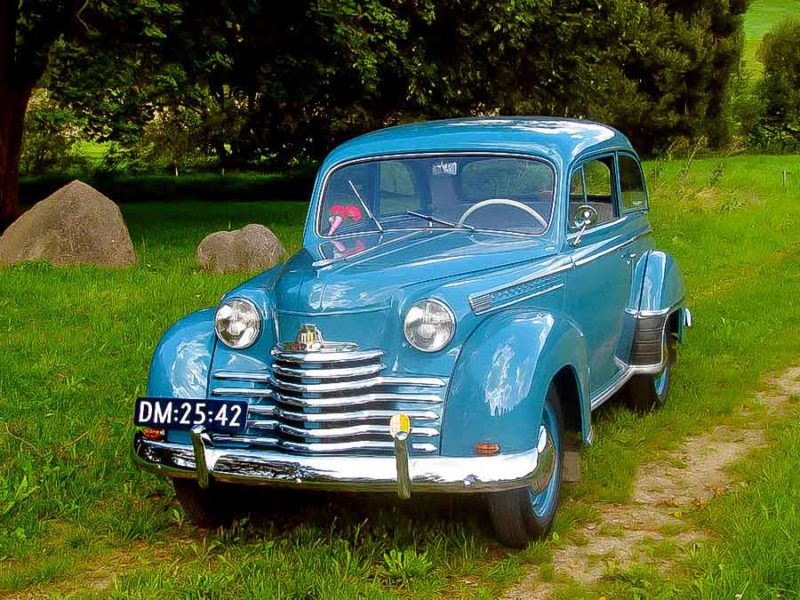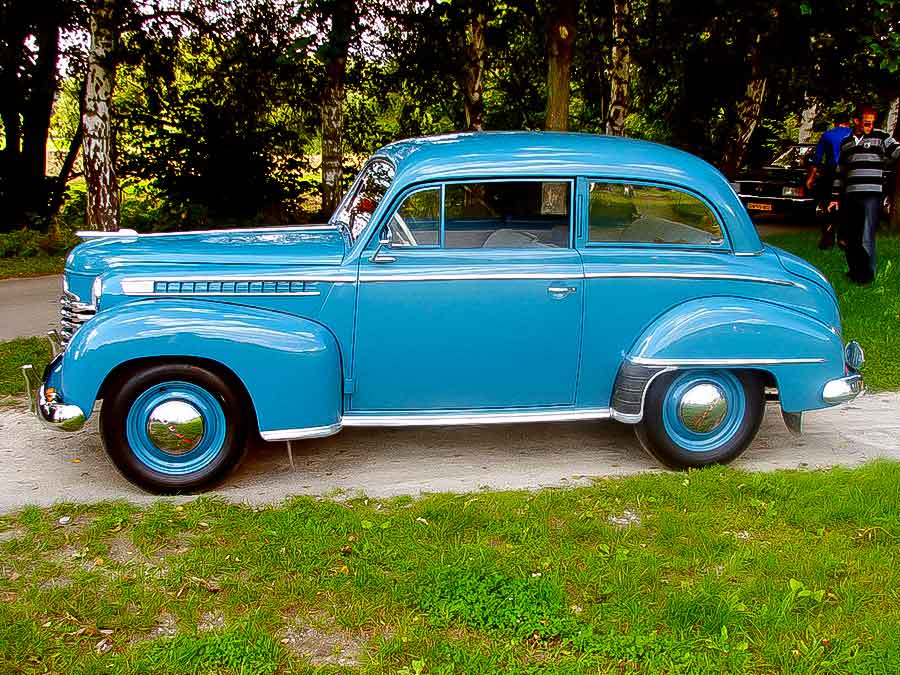Before we tell Nico's story, it is good to take note of the advice that the FEHAC gives us when it comes to driving an old vehicle with outdated features. (FEHAC is the advocate of our historic vehicles.)
By: Dirk de Jong
Common sense recommendations
- Understand the possibilities and the limitations.
- Look out, know if you are seen.
- Make your intention clear in a timely manner.
- Drive with common sense and understanding of other road users.
- Calm driving can cause irritation to other road users.
Nico: “Irritation? I've even made my parents and friends happy with wedding rides and other anniversaries. In fact… when we are on the road, people like to drive a little slower to look and enjoy. As a regular guest at classic car events, our 'compliments archive' is always well supplemented.”
Opel is the beloved car brand
Opel is Nico's beloved car brand. He calls his garage the 'cherry room' where various old-timers are shining. That makes him feel proud every time.
Opel club
Opel club members help each other. Sometimes with parts, sometimes with advice. When - after the restoration of his Opel Blitz was completed - he came into conversation with a club member who offered his black Opel Olympia, the incentive for a new challenge came immediately. Some things come your way without you looking for them. The Opel Olympia was in good condition, but unfortunately poorly painted. When after some time a leak occurred at the windscreen and it also turned out that the rust beetles had wreaked havoc there, it was decided to give the car a whole new coat of paint and the car became Neptune blue instead of black.
What's the beauty of a classic?
It's driving and enjoying, with people around you with the same interest. They are allowed to look at his 'dated' Opel, even touch it, take pictures and take a seat behind the wheel. If other enthusiasts enjoy it, it is also enjoyable. Isn't that a bit of courtesy? Nico can say it in one sentence: “Everything is in favor of Opel.”




How charming that my response to this article was declined…. In my opinion, it gave a perfect picture of the love for the Opel brand. Thanks and goodbye. Not.
This has to do with the fact that there is a link in the text. They are not rejected, but are not immediately published so that an editor can look at them first. That has nothing to do with the comment itself, but mainly with the fact that spammers often inject comments via automated systems. So a kind of security.
I grew up with a 1950 Opel Olympia. Spare wheel on the back and a narrow rear window. My father bought it in 1956 (I was 3) and drove it until 1968. Everything about that car was replaced over the years. From a VEGE exchange engine to completely new upholstery. There was a time when the hood ornament was banned and later mud flaps became mandatory. Been everywhere with that puddle. First gear out of synch, which resulted in some perilous moments if you happened to end up behind a crawling truck in the mountains. Get out and can of wood behind rear wheel.
With double clutching you get every unsynchronized gear inlaid.
Double clutching is certainly possible. I'm familiar with that, but not on a steep slope
There's no time for that. As soon as you go off the gas you stand still or go back down
For the enthusiast, have a look at this.
Two German brothers guard and preserve and restore and enjoy the Opel heritage:
https://www1.wdr.de/mediathek/video/sendungen/video-nur-fliegen-ist-schoener-ein-leben-fuer-opel-100.html
Thanks for the link.
Of course in the sixties we didn't have a car, but our "old" neighbor did, and sometimes drove along. Also jumped at his 60+ age from the 'high' diving board in our regional outdoor swimming pool.
Anyway, he had a car, was always in the garage, but was something different from a Berini, let alone a Kreidler or Zundapp.
Personally, I've always had mixed feelings, I found him ugly, over-proportioned.
Anyway, considering the time, my father was allowed to buy a car for his work… no, no lease box – take out a personal loan and km. declare!
Opel; has always been for me a dualism between rational and emotional aspects.
At that time, I kicked my 'padded zundapp, to 100cc' I had to take my moped from Doetinchem to Arnhem, where I was at school, every then (in the summer).
My father bought a P1 with the coins from the employer and then a number of "business implementation" ...
What a frustration, neighbor had the Olympia in the shed, neighbor could afford the Opel DiplomatV8 at the time (later also an Astin Martin Lagonda and RR).
If decades have been clear about “social classes”, it must have been the 60th.
But, also somewhat infected myself, I helped me with a 2nd hand, Rekord 20.0, Commodore 2.5 Berlina, an Omega 20i GLS, But then Opel was passé for us!
Crazy that I now look with different eyes than 40 years ago – then – on my Zundapp or later Lambretta (which I converted into a 'chopper' – a shame!
Still quite a unique car.
Calm driving and irritation (recommendation5) immediately raises two thoughts in my mind.
1. I can tear as hard as I want with my classic car, but from a car with more than 200 HP I will always seem to stand still. So I don't get rushed because that doesn't change the situation.
2. Why is the acceptance of irritation about a slow car a normal phenomenon and is the irritation about the (aggression) of the fast car owners not seen the other way round?
I am reading here a kind of reversed reality of social intercourse. We (classic riders) have to efface ourselves because otherwise the 'hasty hats' could get irritated.
You could give as recommendation6 “The public road is for everyone. It would be nice if everyone took that into account.” Recommendation7: “For good racing you have the circuit, for irritation you have Zen”.
Then I'll tell you something about this car. The Oly'51, as this type is called, is the last direct successor to the Olympia of 1935. Indeed, named after the famous Berlin Olympiad, where Hitler saw a showroom of Nazism and Leni Riefenstahl her famous film “Olympia” shot. For the occasion, General Motors decided to let the newest member of the Olympic flame travel from Athens to Berlin. And that wasn't the only thing. The Olympia was used in almost all rallies of its time, winning time and time again.
That was important, because this car was the very first series production car in the world to have a completely unibody body. And a car with absolutely no chassis in sight, that made potential customers hesitant.
Not necessary. The Opel designers led by chief engineer Hans Mersheimer did not take any risks and such an Olympia still feels like reinforced concrete. The engine was fitted with a 1300cc OHV with the special feature of a crankshaft bearing four times. In this 1952'er is the same block, but then drilled up to 1500cc, which produces about 38 hp and gives the car a top of 115 km/h, which he can also sustain continuously on the highway. It was called “Autobahnfest”. It was also for sale as a convertible coach with an open roof and as a van. In 1936 its smaller brother, the Kadett, appeared to offer competition to the upcoming KdF-Wagen, the later Volkswagen. They would indeed become the great German rivals after the war.
The technology of the Olympia had meanwhile passed the toughest test track in history, called “World War II”, because Opel was like the rest of German industry.
purveyor to Hitler's war machine (GM collected the billions in profit after the war, just like Ford Motor Company, and to top it off, they also received compensation for the bombed Opel factory in Rüsselsheim). The Olympia engine was used in countless army vehicles and generators and, in addition to the hot Sahara (with Rommel's Afrikakorps), also had to endure the Russian winter (including the icy siege of Leningrad and the even more icy Battle of Stalingrad). They were more successful than their bosses and after the war Opel would have to give up her Kadett as a war repair so that he could get a second life as a Muscovite.
What else do we have in our hands with the Olympia? In this last update it was already a bit old-fashioned, with its 30s lines, but at least the trunk could be opened from the outside, the spare wheel moved to the bottom, it had a then very modern steering gear that operated the three-speed gearbox, a large ivory-coloured steering wheel and, as an archaic relic, friction shock absorbers and turn signals hidden in the door jamb. There was no heater, it had to be paid extra for and the windshield wiper worked on the engine vacuum, which (ahem) was not always handy.
In short: top quality technology and steel for the common man, and in 1953 the pontoon version was released as Olympia Rekord based on more or less the same technique.
Interesting Olav!
Small correction: the windscreen wipers do not work with the engine vacuum, but are mechanically coupled (by means of a cable) to the engine. That still means that it is not always convenient: at low speed the wipers go slowly and at high speed they go fast.
OK! Thanks for the addition!
I remember sitting in the back of this Olympia as a kid and telling my dad at every corner what turn signal was needed because in the winter they would freeze or they would be weak and wouldn't come out and we would have to hit the backseat give the B-pillar to make them unfold. Also, the car was definitely not child-friendly, with hard iron bars at teeth height at the back of the front seats. But it was a very solid thing, my parents bought it when it was ten years old and kept it until 1967, so fifteen years. That at a time when most cars could be swept up after seven to ten years.
Yes, I still have calluses on the heel of my hand due to the blows on the metal “b pillar” to make the turn signal stick out all the way. Even in non-freezing weather this was sometimes necessary, otherwise the pointer only went out halfway. When turning right at one traffic light, it sometimes happened that a cyclist ran into the protruding direction indicator.
Good story!
Only in my opinion this was not the first series production car with a self-supporting body; earlier there was already Lancia (early 20s) and the Citroën T.A. (1934).
Damn, you're right and I should have known that. Never thought of it, the Citroën TA was well known anyway. Wikipedia also states that the 1935 Opel Olympia was “one of the first mass-produced cars with a unibody construction” and not “the first”. In any case, this Opel was a modern car in the 30s.